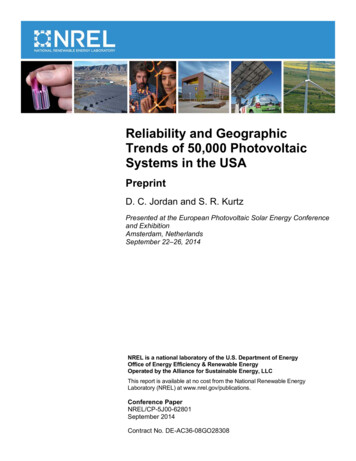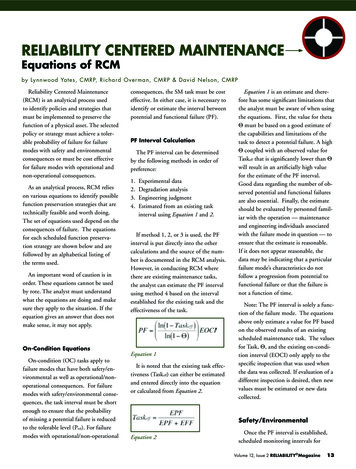
Transcription
Reliability and GeographicTrends of 50,000 PhotovoltaicSystems in the USAPreprintD. C. Jordan and S. R. KurtzPresented at the European Photovoltaic Solar Energy Conferenceand ExhibitionAmsterdam, NetherlandsSeptember 22–26, 2014NREL is a national laboratory of the U.S. Department of EnergyOffice of Energy Efficiency & Renewable EnergyOperated by the Alliance for Sustainable Energy, LLCThis report is available at no cost from the National Renewable EnergyLaboratory (NREL) at www.nrel.gov/publications.Conference PaperNREL/CP-5J00-62801September 2014Contract No. DE-AC36-08GO28308
NOTICEThe submitted manuscript has been offered by an employee of the Alliance for Sustainable Energy, LLC(Alliance), a contractor of the US Government under Contract No. DE-AC36-08GO28308. Accordingly, the USGovernment and Alliance retain a nonexclusive royalty-free license to publish or reproduce the published form ofthis contribution, or allow others to do so, for US Government purposes.This report was prepared as an account of work sponsored by an agency of the United States government.Neither the United States government nor any agency thereof, nor any of their employees, makes any warranty,express or implied, or assumes any legal liability or responsibility for the accuracy, completeness, or usefulness ofany information, apparatus, product, or process disclosed, or represents that its use would not infringe privatelyowned rights. Reference herein to any specific commercial product, process, or service by trade name,trademark, manufacturer, or otherwise does not necessarily constitute or imply its endorsement, recommendation,or favoring by the United States government or any agency thereof. The views and opinions of authorsexpressed herein do not necessarily state or reflect those of the United States government or any agency thereof.This report is available at no cost from the National Renewable EnergyLaboratory (NREL) at www.nrel.gov/publications.Available electronically at http://www.osti.gov/scitechAvailable for a processing fee to U.S. Department of Energyand its contractors, in paper, from:U.S. Department of EnergyOffice of Scientific and Technical InformationP.O. Box 62Oak Ridge, TN 37831-0062phone: 865.576.8401fax: 865.576.5728email: mailto:reports@adonis.osti.govAvailable for sale to the public, in paper, from:U.S. Department of CommerceNational Technical Information Service5285 Port Royal RoadSpringfield, VA 22161phone: 800.553.6847fax: 703.605.6900email: orders@ntis.fedworld.govonline ordering: http://www.ntis.gov/help/ordermethods.aspxCover Photos: (left to right) photo by Pat Corkery, NREL 16416, photo from SunEdison, NREL 17423, photo by Pat Corkery, NREL16560, photo by Dennis Schroeder, NREL 17613, photo by Dean Armstrong, NREL 17436, photo by Pat Corkery, NREL 17721.NREL prints on paper that contains recycled content.
RELIABILITY AND GEOGRAPHIC TRENDS OF 50,000 PHOTOVOLTAIC SYSTEMS IN THE USAD.C. Jordan,* S.R. KurtzNational Renewable Energy Laboratory (NREL), 16253 Denver West Parkway, Golden, CO 80401*Tel: 1-303-384-6762; Fax: 1-303-384-6790; email: dirk.jordan@nrel.govABSTRACT: This paper presents performance and reliability data from nearly 50,000 photovoltaic (PV) systems totaling 1.7gigawatts installed capacity in the USA from 2009 to 2012 and their geographic trends. About 90% of the normal systems andabout 85% of all systems, including systems with known issues, performed to within 10% or better of expected performance.Although considerable uncertainty may exist due to the nature of the data, systems in hotter climates appear to exhibit somedecline that could be a combination of insolation variability, soiling and possible degradation. Special causes ofunderperformance and their impacts are delineated by reliability category. Hardware-related issues are dominated by inverterproblems (totaling less than 0.5%) and underperforming modules (totaling less than 0.1%). Furthermore, many reliabilitycategories show a significant decrease in occurrence from year 1 to subsequent years, emphasizing the need for higher-qualityinstallations, but also the need for improved standards development. The probability of PV system damage because of hail isbelow 0.05%. Singular weather events, such as a single lightning strike to a transformer or a hurricane, can have a significantimpact on production. However, grid outages are more likely to have a significant impact than extreme weather events that causePV system damage.Keywords: photovoltaic, PV system, system performance, reliability, durabilityHistorically in the PV industry, as in many other industries,these field-quality components have been evaluatedseparately. Yet, it is their synergistic nature, as shown inFig. 1, that determines risk.1INTRODUCTIONWorldwide, trillions of dollars of capital are availablefor investing in photovoltaic (PV) systems, buttechnological and performance risks, among other barriers,remain limiting factors to investment in the PV asset class.In addition, PV module prices have declined dramaticallysince 2009, raising questions about the quality of modulesand systems. Bankable PV—that is, PV that inspiresinvestors’ confidence—requires three components, asrepresented by the three-legged stool in Fig. 1. Consistentmanufacturing, durable design, and system verification arerequired at the manufacturing and installation level forbankable PV. International standards enable consistentachievement and identification of quality components.When tracking performance in the field, the three elementsof success are performance, reliability, and durability(where reliability is the discrete occurrence of disruptiveevents and durability is the gradual decline ofperformance). Therefore, documenting field performance,reliability, and durability enables investors and consumersto quantitatively assess risk of poor performance.To assess the current state of the industry as a whole,all three categories of PV field quality are needed for alarge number of systems in multiple climates. However,such an assessment is difficult to execute due to itsenormous complexity. A non-comprehensive synopsis ofexcellent field-quality studies is summarized in Table I.Recent years have seen an increased emphasis of moresynergistic studies; however, these studies are typicallylimited by the number of systems or their geographicaldistribution.Table I: Synopsis of field-quality studies.Performance Reliability 1][12]–[16][17], [18][19], [20]This study evaluates data from almost 50,000 systemsinstalled in the USA between 2009 and 2012 and aims tostatistically assess all three PV field-quality categories.2METHODThe American Recovery and Reinvestment Tax Act(ARRTA) 1603 Program provided payments (in lieu of taxcredits) as partial reimbursement for installation ofrenewable energy systems. The 1603 Program required thatsystem operation or construction commence in 2009, 2010,or 2011. In general, residential systems were not eligiblefor the program unless the property was subject todepreciation. Applicants provided information describingeach system before being approved for funding.Additionally, each recipient agreed to provide annualreports for each of the first five years of system operation.Figure 1: Three field-quality components (representedby the legs of the stool) for bankable photovoltaics.1This report is available at no cost from the National Renewable Energy Laboratory (NREL) at www.nrel.gov/publications.
Table II: Summary of data categories with examples.Data CategoryNormalProjectHardwareData CollectionWeatherNo informationSubcategoryN/ADelayUtility/Grid rRepairFuse, Wiring, BreakerModule DefectiveModule RecallMissing DataData AcquisitionPoor Initial tter-than-expected generation. Normal variance in solar irradiance.Delay in construction for up to two months. Initial start-up delay.Erratic voltage on grid line shuts down inverter.PV system was turned off for building's renovation process.The system design (tilt) changed after initial application.The house went into foreclosure and the system has been shut down.The inverter had a problem and needed to be replaced.Maintenance interruptions. Difference due to unscheduled outages.Multiple string fuses had to be replaced.Solar panel damage, system underperformed.System was shut down due to module recall.We are missing production data from April and May.Monitoring equipment was not properly engaged until 2011.We overestimated the system’s base power output in optimal conditions.Heavy snow fall in the winter reduced generation in the winter.Original production was based on the original shading analysis.Transformer was struck by lightning; PV systems were shut down.Power outage due to Hurricane Sandy.For some unknown reason, the system is underperforming.This study analyzes a subset of the application data(the nameplate rating of the system, zip code, andestimated annual production) and the annual report data(annual AC electricity production and explanation if theactual production was lower than had been estimated). Theanalyzed data set included nearly 50,000 PV systems in theUSA, as shown in Fig. 2, ranging in size from 0.5 kW to 25MW. All systems combine to more than 1.7 gigawatts ofinstalled capacity. The data summarized here arose fromproduction in 2009 to 2012, resulting in more than 70,000monitoring years.The data set was created to document the value of theARRTA investment. The data set consisted of annual ACenergy production, zip code location, annual estimatedproduction, the nameplate rating of the system, and annualcomments relating to the performance of the system. Onelimitation was the lack of irradiance and system mountingconfiguration data. Therefore, only relative performancewith respect to expected performance and nameplate ratingcould be analyzed.The challenge with such a large data set based onmultiple party entries is to filter for physical implausibility.Thus, entries were eliminated that showed a predictedcapacity factor outside the range of 3%–40%. In addition,annual production values that matched nameplate ratingand consecutively matching annual production values wereeliminated because those most likely originated fromincorrect data entry. Lastly, in 0.5% of all cases, unitconfusion—e.g., Wh or MWh entries instead of kWhentries—required adjustment.Figure 2: Geographical distribution of analyzedinstallations color-coded by year of installation (a), andcumulative nameplate capacity by state (b).3PERFORMANCEExceedance probabilities such as P50 and P90, whereP stands for probability, are often used in quantitative riskassessment. The P50, the median, indicates that 50% of thedata fall above this value and is equivalent to the mean forsymmetric distributions. P50/P90 analyses for long-termweather data have been published recently [22]. Similarly,P50/P90 values can aid in the technical and financialperformance risk assessment of a broad portfolio of PVsystems.As detailed previously, the data were classified intocategories and subcategories according to theirperformance comments as reproduced in Table II forclarification [21].2This report is available at no cost from the National Renewable Energy Laboratory (NREL) at www.nrel.gov/publications.
Analysis such as shown in Fig. 3 and described hereimplies that the data are consistent with historical annualdegradation rates of about 0.5%–1% median and notsignificantly higher. The CDFs of Fig. 3 are useful forvisualizing the overall distribution; however, the P50s andP90s are difficult to quantify from these graphs. Figure 4shows the P50s and P90s for the normal data, normal dataadjusted for degradation of 0.5%/year and 1%/year, and alldata. For the P50s, 0.5%/year degradation appears toreduce the year-to-year variability to better than 1%/yeardegradation. For the P90s, the 1%/year degradation appearsto give a better fit, with the exception of year 1. The P90values for the normal categories are spread around 0.90.Thus, about 90% of all normal systems equal or exceed90% of the predicted production. Finally, the P90 valuesfor all systems, including systems with known issues, aresomewhat lower but are still centered on 0.85.Figure 4: P50 and P90 values of the measured productionover predicted production values for normal data,differently degradation-adjusted data, and all data.Figure 3: Cumulative distribution functions of measuredproduction over predicted production for each operationalyear for: (a) normal systems, (b) normal systems takinginto account 0.5%/year degradation, and (c) all data. Alsoshown are P90 (dotted line), P50 (solid line), and unityratio (vertical dashed line).4CLIMATERegional or climatic performance difference is ofinterest, in addition to the performance of the entire PVportfolio. The performance of the 1603 Program systems isfurther analyzed according to the approximate outlines ofthe climate zones in the USA, as shown in Fig. 5.Figure 3 shows the cumulative distribution functions(CDF) for the ratio of the measured to the predicted annualperformance for (a) normal systems, (b) normal systemstaking into account 0.5%/year degradation, and (c) all data,colored by year. The P50 and P90 values are shown byhorizontal solid and dotted lines, respectively. In addition,as a guide to the eye, a unity ratio of measured andpredicted production values is given by a vertical dashedline. The absence of any discontinuities or plateausindicates that fairly smooth tails extend on both sides of theP50 value.It is of considerable interest that the P50 valueconsistently exceeds the unity ratio, indicating that normalsystems overproduce expectations by several percent.Assuming a degradation rate of 0.5%/year, which has beenshown to be the most often reported rate in the literature[11], the yearly CDF curves collapse more around the 0.90value at the P90 point. (Note, however, that the 0.5%/yeardegradation rate is dominated by module data and notsystem data.)Figure 5: General geographic distribution of climate zonesin the USA.3This report is available at no cost from the National Renewable Energy Laboratory (NREL) at www.nrel.gov/publications.
In contrast to these more moderate climates are the twohot climates shown in Fig. 7. The Desert climate of theNorth American Southwest and the Hot & Humid climateof the Southeast show a ratio that seems to decline witheach operational year at the P50. The low value of the thirdoperational year in the Hot & Humid climate may beaffected by the relatively low number of data points. Forthe Desert climate, the P90 is consistent with the values ofthe moderate climates for the first year of operation, butthen decreases with each subsequent year. In the Hot &Humid climates, the P90 is below 90% for all operationalyears. Considerable uncertainty could be present becauseof the nature of the data set and the relatively smallgeographic region of the desert Southwest; however, thisdownward trend could be a combination of interannualinsolation variability, soiling or possible degradation.Figure 8 shows a subset of the desert systems that beganproduction within 3 months in 2010 partitioned bydifferent system size. The smaller systems show abroadening of the distribution in year 2 and a decline inyear 3. The larger systems do not show the same trend forthe approximate same calendar period indicating thatperhaps regular cleaning of the larger systems could beresponsible. If the decline for the smaller system was dueto degradation, the rate would be ca. 1 %/year, consistentwith recent findings. [23-26] A similar analysis for the hotand humid climate was not possible due to the low numberof data points.Figure 6: Cumulative distribution functions of measuredproduction over predicted production for Continental,Mediterranean, Marine West Coast, and Steppe climates.Also shown are P90 (dotted line), P50 (solid line), andunity ratio (vertical dashed line).Figure 6 shows cumulative distribution functions ofthe measured production over predicted production for fivedifferent climates. As in Fig. 3, P90 (dotted line), P50(solid line), and unity ratio (vertical dashed line) are shownas guides to the eye. In addition, the number of data pointsper category is also given. In some climate zones, thefourth operational year is missing due to the low number ofdata points. The P50 for operational years 2 to 4 shows avalue at or above the values for the first operational year,indicating that degradation, if present, may be very small.The P90 of the Marine West Coast climate shows a lowtail, but this may be due to the low number of data points.Figure 7: Cumulative distribution functions of measuredproduction over predicted production for Desert and Hot &Humid climates. Also shown are P90 (dotted line), P50(solid line), and unity ratio (vertical dashed line).4This report is available at no cost from the National Renewable Energy Laboratory (NREL) at www.nrel.gov/publications.
Because the hardware category is dominated byinverters and unspecified repairs, the number ofoccurrences is large enough to further partition the eventsby geographical location. Figures 10 and 11 show theCDFs for inverters and repairs, respectively, color-codedby climate. In addition, the number of data points availableis given in parentheses.Figure 8: Cumulative distribution functions of measuredproduction over predicted production for systems in thedesert and system size. All systems began productionwithin 3months in 2010. Also shown are P90 (dotted line),P50 (solid line), and unity ratio (vertical dashed line.Figure 10: Cumulative distribution functions of measuredproduction over predicted production for systems reportinginverter issues, colored by different climate zones. Alsoshown are P90 (dotted line), P50 (solid line), and unityratio (vertical dashed line.5For systems reporting inverter issues, the P50 of theCDFs for all but two climates are virtually identical; onlythe Desert and the Mediterranean climates showsignificantly reduced values. The Hot & Humid climateshows a P50 that is similar to the moderate climates;however, it also displays a significantly lower tail,resulting in a much lower P90. Systems reportingunspecified repairs show similar P50s, but significantlylower P90s for the hotter climates. This may indicate thatinverter and unspecified repairs have a more significantimpact in the hotter climates, compared to the moremoderate climates.UNDERPERFORMANCEThe data for the vast majority of systems fall in thenormal category—with only 2%–4% of all systems,depending on the operational year, underperforming with aknown cause. In this section, we discuss the causes for theunderperformance and their geographic distribution. Figure9 shows project-related issues as a function of year withabsolute count (top) and percentage (bottom). Hardwarerelated issues are primarily dominated by inverter problemsand unspecified repair outages. Surprisingly, generalelectrical problems, such as those with fuses, breakers, andwiring, are important categories. "Defective orunderperforming modules" is the next category and is splitout from module recalls. "Unauthorized shutdowns" is asmall but noticeable category and emphasizes the necessityof locks on interconnections.Figure 11: Cumulative distribution functions of measuredproduction over predicted production for systems reportingunspecified repairs, colored by different climate zones.Also shown are P90 (dotted line), P50 (solid line), andunity ratio (vertical dashed line).Figure 9: Categorized hardware-related issues as afunction of operational year as the (top) number ofoccurrences and (bottom) percentage of total.5This report is available at no cost from the National Renewable Energy Laboratory (NREL) at www.nrel.gov/publications.
Figure 13 shows the impact of weather-related eventsin 2011 and 2012 for the Northeast USA. In 2011, themajority of the underperformance in the region was causedby snow losses, an important consideration for futureproduction estimation. In 2012, the most influential eventof the region was the impact of Hurricane (Superstorm)Sandy. When considering the impact of a hurricane on PVproduction, damage to the system is not necessarily theinevitable conclusion, as shown in Fig. 14.In the weather category, the lightning and hurricanesubcategories show a surprisingly large impact. Similar toFig. 9, Fig. 12 shows the count and percentage for eachweather-related subcategory as a function of calendar year.Because singular weather events may occur duringdifferent operational years of the individual systems, theweather events are graphed as a function of calendar year.The lightning subcategory shows a low percentage ofoccurrence in 2010 and 2012, yet displays a significantincrease in 2011. The cause was a single lightning strike toa transformer that led to the precautionary shutdown of allPV systems in the vicinity during the repair. Therefore, theimpact of a lightning strike incident may be morewidespread and significant than one would initiallyassume. Finally, the significant increase in the hurricanesubcategory in 2012 was the well-publicized event ofSuperstorm Sandy.Figure 14: Pareto chart of hurricane impact on PVproduction.In the majority of the cases, the exact impact on thePV system is unclear, typified by entries that the systemwas “affected by the hurricane.” Although the entries maynot be completely accurate, it is likely that if the PVsystem had been damaged, then the comments would notethis explicitly. In 30% of all cases, grid outages resultingfrom the hurricane led to yearly underproduction of the PVsystem. Damage to the system consisting of unspecifieddamage, inverter, data acquisition, microinverter and paneldamage was specified in only 24% of all cases. In less than10% of all cases, prolonged overcast skies led to reducedinsolation and therefore to slight underproduction. Lastly,flooding associated with the storm surge had an impact onyearly PV underproduction.Figure 12: Categorized weather-related issues as afunction of calendar year as the (top) number ofoccurrences and (bottom) percentage of total.6CONCLUSIONWe have shown the annual performance analysis ofnearly 50,000 PV systems in the USA totaling 1.7gigawatts installed capacity. About 90% of the normalsystems performed within 10% or better of expectedrelative performance. Considerable uncertainty exists dueto the nature of the data, Systems in hotter climates appearto exhibit some decline that could be a combination ofinterannual irradiance variation, soiling and possibledegradation. Special causes of underperformance and theirimpacts were analyzed and presented. Hardware-relatedissues were dominated by inverter problems (totaling lessthan 0.5%) and unspecified repairs. Both causes exhibit alow performance tail in hotter climates, possibly indicatinga climate-specific impact. In contrast, underperformingmodules composed less than 0.1% of all data. Furthermore,many reliability categories show a significant decrease inoccurrence from year 1 to subsequent years, emphasizingthe need for higher-quality installations but also the needFigure 13: Weather impact on the Northeast USA during2011 and 2012.6This report is available at no cost from the National Renewable Energy Laboratory (NREL) at www.nrel.gov/publications.
for improved standards development. The probability ofPV system damage because of hail is below 0.05%.Singular weather events, such as a single lightning strike toa transformer or a hurricane, can have a significant impact.However, the loss in production is more likely to beassociated with subsequent grid outages than with PVsystem damage.[12] E. Hasselbrink, M. Anderson, Z. Defreitas, M.Mikofski, Y. Shen, S. Caldwell, A.Terao, D. Kavulak,Z. Campeau, D. DeGraaff, Validation of the PVLifeModel Using 3 Million Module-Years of Live SiteData, 39th IEEE Photovoltaic Specialists Conference,Tampa, FL, USA, 2013, 7–13.[13] C.E. Chamberlin, M.A. Rocheleau, M.W. Marshall,A.M. Reis, N.T. Coleman, P.A. Lehman, Comparisonof PV Module Performance before and after 11 and 20Years of Field Exposure, 37th IEEE PhotovoltaicSpecialists Conference, Seattle, WA, USA, 2011,101–105.[14] D. Polverini, M. Field, E. Dunlop, W. Zaaiman,Polycrystalline Silicon PV Modules Performance andDegradation over 20 Years, Prog. Photovolt: Res.Appl. 2013; 21( 5), 1004–1015.[15] P. Sanchez-Friera, M. Piliougine, J. Pelaez, J.Carretero, M. Sidrach de Cardona, Analysis ofDegradation Mechanisms of Crystalline Silicon PVModules after 12 Years of Operation in SouthernEurope, Prog. Photovolt: Res. Appl. 2011; 19(6),658–666.[16] E. Lorenzo, R. Zilles, R. Moretón, T. Gómez, A.Martínez de Olcoz, Performance Analysis of a 7-kWCrystalline Silicon Generator after 17 Years ofOperation in Madrid,” Prog. Photovolt: Res. Appl.2013, DOI: 10.1002/pip.2379.[17] N. H. Reich, A. Goebel, D. Dirnberger, K. Kiefer,System Performance Analysis and Estimation ofDegradation Rates Based on 500 Years of MonitoringData, 38th IEEE Photovoltaic Specialists Conference,Austin, TX, USA, 2012, 1551–1555, DOI:10.1109/PVSC.2012.6317890.[18] B. Marion, J. Adelstein, K. Boyle, H. Hayden, B.Hammond, T. Fletcher, B. Canada, D. Narang, A.Kimber, L. Mitchell, G. Rich, T. Townsend,Performance Parameters for Grid-Connected PVSystems, 31st Photovoltaic Specialists Conference,Lake Buena, FL, USA, 2005, 1601–1606, DOI:10.1109/PVSC.2005.1488451.[19] T. Friesen, D. Chianese, A. Realini, G. Friesen, E.Burà, A. Virtuani, D. Stepparava, R. Meoli, TISO10kW: 30 Years of Experience with a PV Plant, 27thEuropean PV Solar Energy Conference, Frankfurt,Germany, 2012.[20] K. Kato, “PVRessQ!” PV Module Failures Observedin the Field, PV Module Reliability Workshop,NREL, Golden, CO, USA, 2012.[21] D.C. Jordan, S.R. Kurtz, Field Performance of 1.7Gigawatts of Photovoltaic Systems, 40th IEEEPhotovoltaic Specialists Conference, Denver, CO,USA, 2014.[22] A. Dobos, P. Gilman, M. Kasberg, P50/P90 Analysisfor Solar Energy Systems Using the System AdvisorModel, World Renewable Energy Forum, Denver, CO2012.[23] D.C. Jordan, J.H. Wohlgemuth, S.R. Kurtz,Technology and Climate Trends in PV ModuleDegradation, 27th European Photovoltaic Solar EnergyConference, 2012, Frankfurt, Germany, 3118–3124.7ACKNOWLEDGMENTSThe authors would like to thank Edward Settle, JasonCoughlin, Doug Gagne, and Dave Peterson. This work wassupported by the U.S. Department of Energy underContract No. DE-AC36-08-GO28308 with the NationalRenewable Energy Laboratory.[1] W.G.J.H.M. van Sark, N.H. Reich, B. Müller, A.Armbruster, K. Kiefer, Ch. Reise, Review of PVPerformance Ratio Development, World RenewableEnergy Forum, Denver, CO, USA, 2012, 4795–4800.[2] N. H. Reich, B. Mueller, A. Armbruster, W. G. J. H.M. van Sark, K. Kiefer, C. Reise, Performance RatioRevisited: Is PR 90% Realistic?, Prog. Photovolt:Res. Appl. 2012; 20:717–726.[3 ] A. Woyte, M. Richter, D. Moser, S. Mau, N. Reich,U. Jahn, Monitoring of Photovoltaic Systems: GoodPractices and Systematic Analysis, 28th European PVSolar Energy Conference, Paris, France, 2013.[4] U. Jahn, W. Nasse, Operational Performance of GridConnected PV Systems on Buildings in Germany,Prog. Photovolt: Res. Appl. 2004; 12:441–448 (DOI:10.1002/pip.550).[5] B. Müller, W. Heydenreich, K. Kiefer, C. Reise, MoreInsights from the Monitoring of Real World PVPower Plants—A Comparison of Measured toPredicted Performance of PV Systems, 24th EuropeanPV Solar Energy Conference, Hamburg, Germany,2009, 3888–3892.[6] K.B.D. Esmeijer, W.G.J.H.M. van Sark, StatisticalAnalysis of PV Performance Using PublicallyAvailable Data in the Netherlands, 28th European PVSolar Energy Conference, Paris, France, 2013.[7] J. Leloux, L. Narvarte, D. Trebosc, PerformanceAnalysis of 10,000 Residential PV Systems in Franceand Belgium. 26th European PV Solar EnergyConference, Hamburg, Germany, 2011.[8] J.H. Wohlgemuth, D.W. Cunningham, A.M. Nguyen,J. Miller, Long Term Reliability of PV Modules, 20thEuropean PV Solar Energy Conference, Barcelona,Spain, 2005, 1942–1948.[9] D. DeGraaff, R. Lacerda, Z. Campeau, Z. Xie, HowDo Qualified Modules Fail –What is the Root Cause?,International PV Module Quality Assurance Forum,San Francisco, CA, 2011.[10] A. Golnas, PV System Reliability: An Operator'sPerspective, IEEE Journal of Photovoltaics 2013;3(1), 416–421, DOI: 0.1109/jphotov.2012.2215015.[11] D.C. Jordan, S.R. Kurtz. Photovoltaic DegradationRates—An Analytical Review, Prog. Photovolt: Res.Appl. 2013; 21(1), 12–29, DOI: 10.1002/ pip.1182.7This report is available at no cost from the National Renewable Energy Laboratory (NREL) at www.nrel.gov/publications.
[24] J. Singh, J. Belmont, G. TamizhMani, DegradationAnalysis of 1900 PV Modules in a Hot-Dry Climate:Results after 12 to 18 Years of Field Exposure, 39thIEEE Photovoltaic Specialists Conference, Tampa,FL, USA, 2013.[25] R. Dubey, S. Chattopadhyay, V. Kuthanazhi, J. J.John, C. S. Solanki, A. Kottantharayil, B. M. Arora,K.L. Narasimhan, J. M. Vasi, A. Kumar, O.S. Sastry,Performance Degradation in Field-Aged CrystallineSilicon PV Modules in Different Indian ClimaticConditions, 40th IEEE Photovoltaic SpecialistsConference, Denver, CO, USA, 2014.[26] N. Strevel, L. Trippel, M. Gloeckler, PerformanceCharacterization and Superior Energy Yield of FirstSolar PV Power Plants in High-TemperatureConditions, Photovoltaics International, 2012.8This report is available at no cost from the National Renewable Energy Laboratory (NREL) at www.nrel.gov/publications.
NREL is a national laboratory of the U.S. Department of Energy . RELIABILITY AND GEOGRAPHIC TRENDS OF 50,000 PHOTOVOLTAIC SYSTEMS IN THE USA . grid outages are more likely to have a significant impact than extreme weather events that cause PV system damage. Keywords: photovoltaic, P










